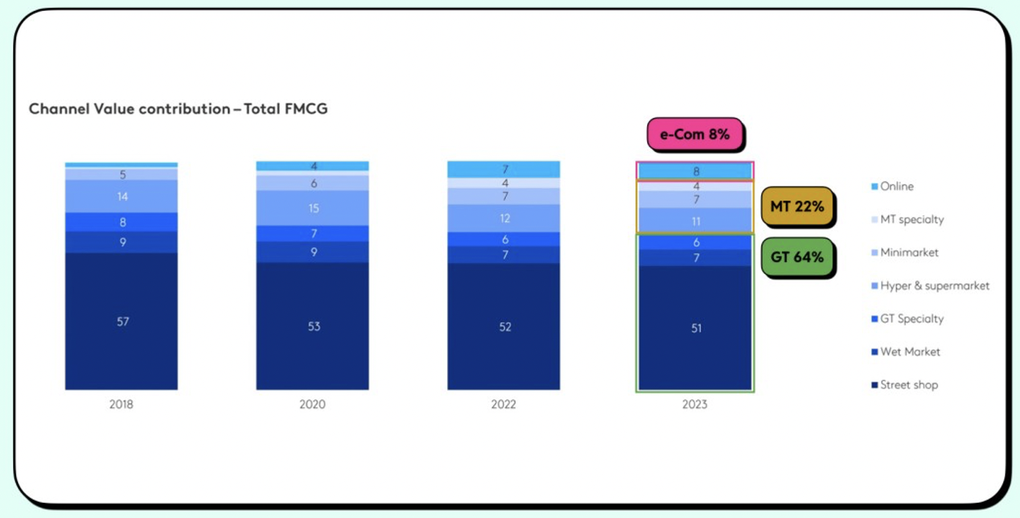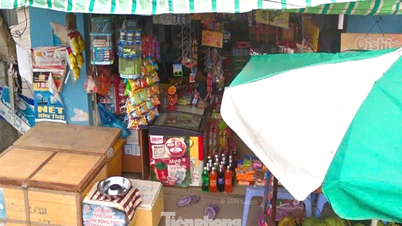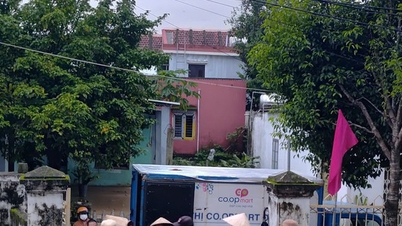After 5 years of almost silence, VinShop was recently relaunched with the new name OneShop, focusing on the target group of more than 5.2 million individual business households, contributing about 30% of GDP and creating jobs for tens of millions of workers.
Or at Thien Long Group, in the beginning of the year, the leader of this business said that the company has 55,000 points of sale across the country. Of which, traditional channels account for more than 70% of revenue and are considered by the CEO of this company as a "money-collecting" channel to invest in other distribution channels.
In another development, after a wave of returning premises from the beginning of 2024 due to high rental pressure and the forecast that online consumption will dominate the market, many locations are gradually being re-leased. This partly shows that with Vietnamese habits, direct shopping still plays an important role in the decision to "spend money".
Once predicted to disappear soon, traditional channels are still "thriving"
In the context of online business and e-commerce boom, there have been many predictions that traditional sales channels (GT - General Trade) will soon "disappear" in the retail industry. However, the reality is contrary to all predictions, traditional channels are still the "pillar" of the industry, accounting for 70% of the current retail distribution channels.
And although online sales are a trend, traditional channels still have roles that other sales channels cannot replace. Simply put, Vietnamese people still prefer to buy groceries.
According to data from NielsenIQ Vietnam, channels such as markets and grocery stores currently account for 75-83% of total market sales, with nearly 1.4 million stores nationwide, contributing about 65% of fast-moving consumer goods (FMCG) industry revenue.
Kantar's report released in April 2024 shows that, despite its growth, e-commerce accounts for less than 8% of sales in the fast-moving consumer goods industry. In particular, in the beverage industry, this rate is even lower, only about 3%. In other words, 92% of consumers still choose to buy at traditional GT channels.

In the FMCG segment alone, traditional channels still account for more than 70% of market share (Photo: Kantar Report).
As long as motorbikes are still running on the road, traditional channels will still "live well"
Speaking to Dan Tri reporter, Mr. Kim Le Huy, Vice President of Consumer Goods, General Director of DKSH Vietnam, said: "As long as motorbikes are still running on the road, traditional channels cannot be replaced."
With many years of experience in the retail industry, Mr. Huy said that it is true that 15 years ago, Vietnamese people thought that traditional sales channels would be replaced. The evidence is that sellers and businesses rushed to invest in modern, online channels, through e-commerce platforms... But reality shows that is not the case.
Vietnam is a densely populated country, so traveling by motorbike is very convenient. A person can stop by the grocery store early in the morning after taking their child to school. Compared to online channels, it is more convenient because it is available immediately, and compared to going to the supermarket, it will save more time. In Vietnam, the consumer mentality still prefers to buy quickly and use immediately.
The investment cost for the current online channel is also very large. For many years, when the online channel was in the development stage, sellers were supported with shipping costs. Today, the platforms or investors push the cost to the seller, plus Vietnam's logistics costs are high compared to the world , leading to the modern channel not being as cheap as many people think.
According to statistics, logistics costs in Vietnam are currently at an average of 16-17% of GDP, a slight decrease compared to previous years (18-19%). This is a relatively high logistics cost compared to other countries in the region and continent. In Japan, logistics costs only account for 11% of GDP, Singapore 8%, Malaysia 13%, Indonesia 13%.
Meanwhile, the cost of investing in grocery stores in Vietnam is very "soft", most of them take advantage of existing houses. Not to mention, with the new generation taking over the stores, they have a new mindset and are opening new models. Many young people, instead of working 8 hours a day in the office, open grocery stores and upgrade the model.
Additionally, with new models, traditional stores even solve the problem of damaged inventory.
Catalyst seen from tightening online product management
Recently, increased management and control of sales and product advertising activities on commercial platforms is contributing to "cleaning" the retail market.
According to experts, this move will promote all channels, from online to media, to operate transparently, bringing consumers products of clear quality and origin.
In addition to complying with regulations and ensuring product quality, the management agency is also aiming to stabilize prices between sales channels, creating a transparent and healthy competitive market.
When prices are unified, traditional channels, which are already favored by consumers for their convenience and reliability, will further promote their advantages.
Source: https://dantri.com.vn/kinh-doanh/vinshop-thien-long-nhat-bac-le-va-chuyen-ban-le-truyen-thong-song-khoe-20251104145237258.htm


































![[Photo] Opening of the 14th Conference of the 13th Party Central Committee](https://vphoto.vietnam.vn/thumb/1200x675/vietnam/resource/IMAGE/2025/11/05/1762310995216_a5-bnd-5742-5255-jpg.webp)













































































Comment (0)